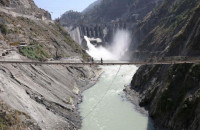More extreme weather events expected: WMO
Two met stations in Pakistan reported temperatures of 50 degrees Celsius on 30th April

PHOTO: REUTERS
The World Meteorological Organisation (WMO) said on Friday it expected weather events to be more and more extreme, as a result of climate change, as they confirmed record 50 degree Celsius temperatures in Pakistan in April.
“Two meteorological stations in Pakistan, just over the [Pakistan-India] border, reported temperatures of at least 50 degrees Celsius on the 30th of April. “This is April, it is not June or July, it is April,” WMO spokeswoman Clare Nullis said on Friday.
“You know, we don’t normally see temperatures of above 50 degrees
Celsius. In fact, as far as we are aware, we have never seen a temperature of above 50 degrees Celsius in April,” Nullis added.
WMO said storms in north-western India were another example of extreme weather. While the monsoon season is not unusual, the intensity of storms that hit Rajasthan and Uttar Pradesh on May 2 and 3 were exceptional, the UN agency added.
Rising poverty, population, climate change a threat to Pakistan’s future
Away from extreme heat in the subcontinent, Nullis said, a new record in carbon dioxide concentration was registered on April 7 in the Izana observing station in Tenerife, Spain. Similarly, in another sign of global warming, Arctic sea ice level, a long-term climate change indicator, has also hit a record-low for April.
“Spain’s Izana observing station in Tenerife, which is part of WMO’s Global Atmosphere Watch Network, reported a new record concentration of carbon dioxide of nearly 414 parts per million on the 7th of April,” Nullis said.
“Other long-term indicators of climate change, Arctic sea ice extent in April was well below average. And in particular ice cover in the Bering Sea was record low at the end of April,” she added.
Nullis warned that this extreme weather will become more extreme.
“We have always seen extreme weather, we will continue to see extreme weather, we think it will become more extreme because of climate change,” Nullis said.
Pakistani environment experts believe that these events indicate a cataclysmic shift in the environment. Asif Shuja Khan, former director general of the Environment Protection Agency (EPA) of Pakistan said that the warnings about the environmental issues have now become a reality.
“We are expecting some three to five-degree temperature [increase] by the end of the century. High-velocity winds and storms occur because of low-pressure system during high temperature,” he said.
Khan said Pakistan’s contribution to the climate change gases emission is less than one per cent but the country remains among the top ten nations affected by global warming. Khan said losses of rupees 10 billion occurred during the floods of 2010 and around 1,200 people lost their lives in the 2015 heat wave.
“Our problem is that we need resources to deal with the climatic disasters. We have to use our resources and give it to our own institutions to be prepared for future calamities,” he said in an interview.



















COMMENTS
Comments are moderated and generally will be posted if they are on-topic and not abusive.
For more information, please see our Comments FAQ